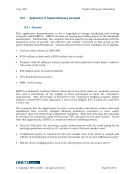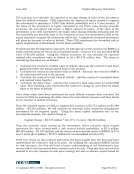June 2007 Capital Adequacy Extension © Copyright 2007, CCRO. All rights reserved. Page 10 of 92 TABLE OF CONTENTS 1. EXECUTIVE SUMMARY.................................................................................................................... 2 1.1. Objective 2 1.2. Revisiting “What is Capital Adequacy” 2 1.3. Adequacy for Economic Value 4 1.3.1. A Word On the Challenge of Accounting Equity Measures 4 1.4. Economic Capital and the Four Categories of Risk 4 1.4.1. Economic Capital and Its Components 5 1.4.2. Operative Risk 5 1.4.3. Market Risk 6 1.4.4. Credit Risk 6 1.4.5. Business Risk & Stress Testing 6 Overall Economic Capital for the Firm 7 1.5. Revealing Possible Shortfalls at Interim Time Periods 7 1.6. Adequacy for Financial Liquidity 8 1.7. Summary 9 2. What is Capital Adequacy? ................................................................................................................. 12 2.1. Capital Adequacy and Credit Ratings 14 2.1.1. Natural Gas Marketing Company Example 16 3. Economic Capital Adequacy ............................................................................................................... 18 3.1. Determining the Equity Component 19 3.1.1. Total Asset Determination 19 3.1.2. Total Asset Determination: Invested Capital 19 3.1.3. Total Asset Determination: Market Value 20 3.1.4. Total Asset Determination: Invested Capital vs. Market Value 20 3.1.5. Total Liabilities Determination 21 3.2. The Risk Capital Requirement 22 3.2.1. Aggregation of Risk Capital 23 3.2.2. The “Cushion” 25 3.2.3. The Time Component 26 3.2.4. Establish Earnings Expectations 27 3.2.5. GAAP Earnings vs. Non-GAAP Earnings 28 4. Operative Risk ..................................................................................................................................... 31 4.1. Introduction 31 4.2. DEFINITION OF OPERATIVE RISKS 32 4.3. Building the Framework for Assessing Operative Risks 33 4.4. Developing an Appropriate Risk Management Framework 34 4.5. Operative Risk Management: Identification, Measurement, Monitoring and Control 35 4.5.1. Operational: Identification of Internal Risks from People, Processes, and Systems 36 4.5.2. Operations: Identification of Physical Risks of the Production, Delivery, and Storage of Energy Commodities 37 4.5.3. Identification of External Risks from Legal, Regulatory, Political, and Environmental Exposures 38 4.6. Operational: Measurement of Internal Risks from People, Processes, and Systems 39 4.7. Operations: Measurement of Physical Risks and External Risks 40 4.8. Monitoring Operative Risks 42 4.9. Controlling Operative Risks 42 4.10. Role of Supervisors 44 4.11. Role of Disclosure 45 4.12. Conclusion 46 5. Credit Risk .......................................................................................................................................... 47 5.1. Introduction 47 5.2. Expected Default Probability (EDP) 49 5.3. Historical Based Approach 50
Purchased by unknown, nofirst nolast From: CCRO Library (library.ccro.org)




























































































